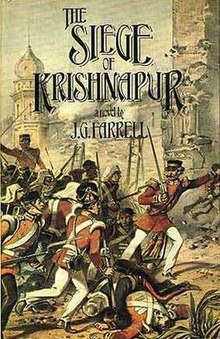The Siege of Krishnapur

First edition
|
|
| Author | J. G. Farrell |
|---|---|
| Country | United Kingdom |
| Language | English |
| Publisher | Weidenfeld & Nicolson |
|
Publication date
|
1973 |
| Media type | Print (Hardcover) |
| Pages | 344 pp |
| ISBN | |
| OCLC | 746629 |
| 823/.9/14 | |
| LC Class | PZ4.F2448 Si PR6056.A75 |
| Preceded by | Troubles |
| Followed by | The Singapore Grip |
The Siege of Krishnapur is a novel by J. G. Farrell, first published in 1973.
Inspired by events such as the sieges of Siege of Cawnpore (Kanpur) and Lucknow, the book details the siege of a fictional Indian town, Krishnapur, during the Indian Rebellion of 1857 from the perspective of the British residents. The main characters find themselves subject to the increasing strictures and deprivation of the siege, which reverses the "normal" structure of life where Europeans govern Asian subjects. The book portrays an India under the control of the East India Company, as was the case in 1857. The absurdity of the class system in a town no one can leave becomes a source of comic invention, though the text is serious in intent and tone.
The novel gained positive reviews from a variety of sources, and won the Booker Prize for Fiction in 1973. Farrell used his acceptance speech to attack the sponsors for their business activities. In 2008 the book was shortlisted along with five other former winners for The Best of the Booker.
The story is set in the fictional town of Krishnapur and tells of a besieged British garrison which holds out for four months against an army of native sepoys. Among the community are the Collector, who is an extremely Victorian believer in progress and father of small children and who can often be found daydreaming of the Great Exhibition; the Magistrate a Chartist in his youth but who sees his youthful political ideals destroyed by witnessing the siege; Dr Dunstaple and Dr McNab who row over the best way to treat cholera; Fleury, a poetical young man from England who learns to become a soldier and Lucy a "fallen" woman rescued from a bungalow who eventually runs a tea salon in the despairing community. By the end of the novel cholera, starvation and the sepoys have killed off most of the inhabitants, who are reduced to eating dogs, horses and finally beetles, their teeth much loosened by scurvy. "The final retreat of the British, still doggedly stiff-upper-lipped through the pantries, laundries, music rooms and ballroom of the residency, using chandeliers and violins as weapons, is a comic delight".
...
Wikipedia
